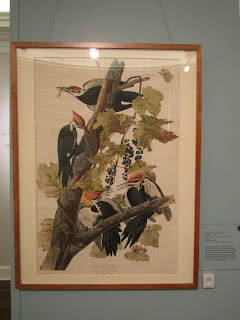 |
| Audubon's "Pileated Woodpecker" |
A collection of first edition prints printed from the watercolor portraits of American birds painted by the naturalist John James Audubon.
It's just a short walk down High Street from the Polk home.
And in about 60 seconds, here we are:
The collection of Audubon prints is "quarantined" here at the Polk Presidential Hall. It cannot be shipped to its next destination because of the cholera, I mean, coronavirus. The cholera has been eradicated in these parts.
The collection is beautiful, but not that big, so here they all are:
"White-Crowned Pigeon." You can see the bald eagle-like head (but not a bald eagle-like body).
"Blue Grosbeak." What is the connection with Polk? Manifest destiny!
"Pinnated Grouse." Polk expanded the country in the early middle of the 19th Century and a naturalist such as Audubon explored the interior, cataloging the new bird species to be found in the American interior.
The description on this one, taken from Audubon's writings, shows some political correctness from the era. In detailing how the pinnated grouse has been hunted nearly to extinction within Kentucky, Audubon wrote: "The Grouse have abandoned the State of Kentucky, and removed (like the Indians) farther to the westward, to escape from the murderous white man." Such sentiment is perfectly appropriate in this context. It is Audubon's own thoughts from that time. It's not current-era P.C. grafted onto the past for the sake of P.C. It is the historical record. And sometimes we deserve the kick in the pants for what we did.
"Zenaida Dove." Audubon was particularly fond of this species.
"Tyrant Fly-Catcher." Audubon, again in his own writing, was incensed at the slaughter of this species in the 1830's. Farmers eradicated this bird because it ate honeybees and farmers wanted to preserve the honeybee.
Yes, I know honeybees are crucial to the ecosystem and crops would fail without them, but ... I'm on the side of the Tyrant Fly-Catcher (and Audubon) on this one: eat those dang bees.
"Pine Creeping Warbler." Audubon painted watercolors of the birds that he saw on his journey through the new lands of the South Central United States.
"Brown-Headed Nuthatch." The watercolors were turned into prints, which were published in book form, and sold to the wealthy elite. The man who Polk beat for the presidency, Henry Clay, was one of those wealthy elite who bought a subscription to Audubon's books of birds.
And, finally, the "Whip-Poor-Will," another of Audubon's favorites. Audubon, writing about the call of the whip-poor-will, wrote: "Only think, kind Reader, how grateful to me must have been the cheering voice of this my only companion, when, fatigued and hungry, after a day of unremitted toil, I have planted my camp in the wilderness, as the darkness of night put a stop to my labours!"
This exhibit was in a single room:
This was definitely not something I was expecting, but it definitely was welcome. And it was appropriate for the Polk era.
There also was a collection of drawings done by children who have seen the exhibit. Most looked like what you would expect children to draw. Cute, but something you keep only if it were your child. Except for two on the bottom row:
Enlarge the picture to see. Look at the middle and the far right birds on the bottom row. Those are very well done. Can't see. I will do the enlarging for you, although I think some of the detail will be lost.
The center one is very well done, but that bottom right corner?
Amazing detail. The kid who did this one is a ringer. And I don't mean a ring-necked pheasant.
















No comments:
Post a Comment